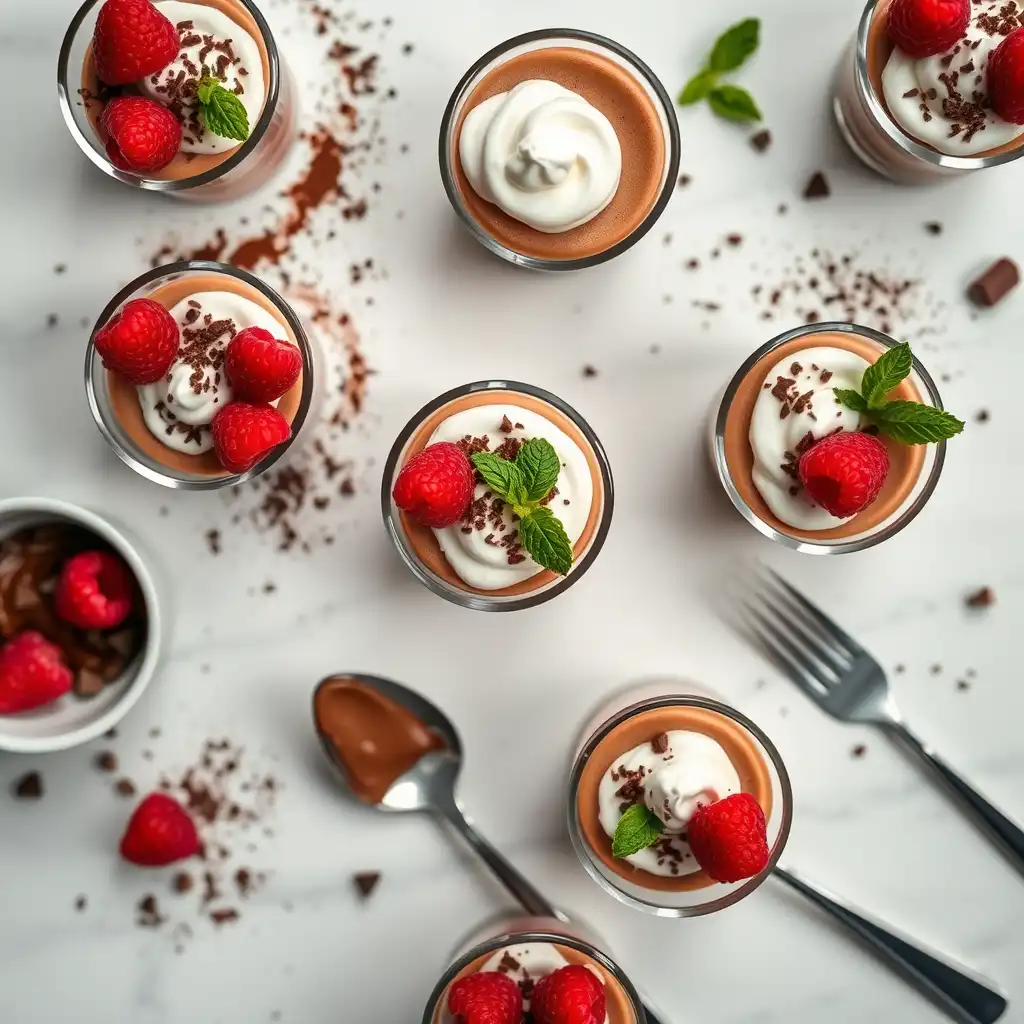Mini Mousse Cup Recipe always makes me think of that night I tried to whip cream by hand at 2am, nearly breaking my wrist, just because the electric whisk was too noisy. The mousse still came out silky, and my neighbors never knew I was whisking like mad while they slept. That’s the thing about mousse—it’s elegant, deceptively simple, and forgiving in ways you wouldn’t expect.
Mini Mousse Cup Recipe is more than just a dessert. It’s a perfect little portion of indulgence, small enough for tasting menus, weddings, or holiday tables. What makes it special is the texture—airy, creamy, almost melting away on your tongue before you’ve fully realized what just happened. A single spoon feels like luxury compressed into a bite.
Mini Mousse Cup Recipe also adapts beautifully to flavors. Chocolate, fruit, coffee, caramel, matcha, even nutty praline—all of them work because mousse is essentially a blank canvas. Professionals love it for that reason. It’s versatile yet technical enough that you can show off real skill, especially with plating and garnish.
Ingredients & Substitutions
Mini Mousse Cup Recipe starts with just a handful of basics, but each one matters.
- Heavy Cream (35–40% fat) – This is your backbone. Light cream won’t whip properly. If you’re stuck, crème fraîche lightened with milk can substitute, but it won’t be as airy.
- Dark Chocolate (60–70% cocoa) – For classic chocolate mousse. Semi-sweet can work, though the deeper the cocoa, the more balanced the sweetness. White chocolate mousse? Then add a pinch of salt and a touch of citrus to cut richness.
- Eggs – Yolks for richness, whites for air. Some chefs skip yolks, but I find they add a custardy depth. Pasteurized eggs are best if serving to kids or elderly.
- Sugar – Just enough to sweeten, never to dominate. Use caster sugar because it dissolves faster than granulated.
- Vanilla or Flavor Extracts – A drop of vanilla, almond, or coffee extract changes the entire character of the mousse.
- Pinch of Salt – Always. Even in dessert. It sharpens flavors and stops everything tasting flat.
Mini Mousse Cup Recipe substitutions can help depending on dietary needs. Coconut cream whips surprisingly well for dairy-free versions, though it brings its own tropical note. Aquafaba (chickpea liquid) whips like egg whites and makes a decent vegan mousse, though texture is slightly less rich. For sugar-free versions, erythritol works, but always use powdered form to prevent graininess.
Mini Mousse Cup Recipe is about ingredient quality. Don’t use chocolate chips—they’re coated to resist melting. Buy a good couverture block, melt it gently, and you’ll see the difference. Cream should be cold, eggs at room temp, sugar fine enough to vanish into air. That’s the game here.
Step-by-Step Instructions
Mini Mousse Cup Recipe begins with melting the chocolate. Use a bain-marie—just a bowl over simmering water. Don’t let the water touch the bowl, don’t rush it. Too much heat and your chocolate seizes into a grainy mess. Stir until glossy, then remove and let it cool slightly.
Mini Mousse Cup Recipe then moves to eggs. Separate yolks and whites carefully, no trace of yolk in the whites or they’ll never whip. Whisk yolks with a little sugar until pale and ribbon-like. This step isn’t just for sweetness—it adds structure. Fold the yolks into the cooled chocolate gently, making sure not to knock out all that air you just created.
Mini Mousse Cup Recipe requires whipped whites next. Whisk until they form soft peaks, add the remaining sugar gradually, and continue until glossy stiff peaks hold. This meringue lightens the chocolate base. Fold one-third in briskly to loosen, then carefully fold the rest with patience. Use a spatula, cut and fold, don’t stir or you’ll collapse the mousse.
Mini Mousse Cup Recipe finishes with whipped cream. Cold bowl, cold whisk, cold cream—everything chilled. Beat to soft peaks only. Overwhipped cream goes grainy and ruins the silkiness. Fold into the mousse last, gently, until the mixture looks even.
Mini Mousse Cup Recipe should be portioned quickly. Pipe or spoon into little cups or shot glasses. Chill for at least 2–4 hours. Don’t freeze, it messes with texture. Before serving, top with whipped cream, berries, grated chocolate, or even edible flowers. Presentation makes the tiny cups irresistible.
Mini Mousse Cup Recipe mistakes are common. Chocolate too hot will scramble yolks. Egg whites underwhipped collapse and make soup. Overwhipped cream gives you butter lumps. The secret? Respect the air you’ve trapped in. Every whisk, every fold, is about protecting those bubbles.
Cooking Techniques & Science
Mini Mousse Cup Recipe succeeds because of aeration. Each element—whipped yolks, whipped whites, whipped cream—introduces air. Folding brings them together without breaking that structure. It’s culinary architecture built on bubbles.
Mini Mousse Cup Recipe uses chocolate emulsification as its backbone. When you fold cream into chocolate, you’re marrying fat with water. If temperatures mismatch, the emulsion breaks. That’s why cooling chocolate before folding is critical—it stays glossy instead of seizing.
Mini Mousse Cup Recipe benefits from understanding protein chemistry. Egg whites whip because proteins unravel and trap air. Sugar stabilizes them, preventing collapse. Cream whips because fat globules trap air and hold water, but if you beat too far, the fat bonds too tightly and squeezes out the liquid—hence butter.
Mini Mousse Cup Recipe tools make a difference. A balloon whisk aerates better than an electric whisk, though it’s tiring. Metal bowls chill faster for cream. Rubber spatulas are gentler for folding than spoons. Even your piping bag choice affects finish—star tip gives drama, round tip looks modern. Professionals obsess over these things for good reason.
Serving & Pairing Suggestions
Mini Mousse Cup Recipe looks best in transparent containers. Shot glasses, mini jars, even tiny martini glasses. The layers and toppings need to be visible. That first glance should already tell the eater it’s going to be lush.
Mini Mousse Cup Recipe pairs beautifully with crunch. Add a biscuit crumb base, a shard of tuile, or caramelized nuts on top. Textural contrast turns soft-on-soft into something unforgettable. Think about color too—a green pistachio crumble over dark chocolate mousse is striking.
Mini Mousse Cup Recipe matches with drinks easily. Espresso heightens chocolate mousse. Champagne cuts richness. For fruit mousses, late harvest Riesling or even a sharp herbal tea makes sense. The mousse is rich, so you want balance beside it, not more heaviness.
Conclusion
Mini Mousse Cup Recipe is a lesson in delicacy. It’s about whipping air into ingredients, protecting it, and serving it elegantly. One wrong whisk and the bubbles vanish. But get it right, and you’ve got a dessert that feels weightless and indulgent at once.
Mini Mousse Cup Recipe works because it’s timeless. French chefs perfected it, home cooks simplified it, and now it sits on menus worldwide in endless variations. For professionals, it’s a showcase of skill. For home cooks, it’s an adventure that feels impressive but doesn’t demand ovens or fancy gadgets.
Mini Mousse Cup Recipe will always have its place because people love foods that feel like more than the sum of their parts. A spoonful of mousse is just cream, eggs, chocolate—but somehow it turns into elegance. That’s why chefs keep returning to it, experimenting with flavors, plating, and textures. It’s endlessly adaptable, always delightful.
FAQs
How do I keep mousse from becoming grainy?
Graininess usually comes from overheated chocolate or overwhipped cream. Melt chocolate gently and whip cream only to soft peaks. Always cool chocolate before folding in eggs or cream.
Can I make mousse cups ahead of time?
Yes, mousse cups actually benefit from chilling a few hours or even overnight. Just don’t garnish until serving, or toppings like fruit and cream will weep and spoil presentation.
What flavors work best besides chocolate?
Fruit purees like raspberry, passionfruit, or mango make stunning mousses. Coffee, caramel, and matcha also shine. Always balance sweetness with acidity or bitterness for depth.
Are raw eggs safe in mousse?
Traditionally, yes, but for safety use pasteurized eggs, especially if serving to vulnerable groups. Some recipes skip eggs entirely, relying on cream and gelatin instead.
How do I plate mini mousse cups for events?
Use uniform glassware, pipe mousse neatly, and garnish consistently. A small accent—raspberry, mint leaf, gold leaf—makes them look professional and elegant.

Olivia P. is a seasoned food blogger at Tastywink, sharing delicious, easy-to-follow recipes inspired by him passion for home cooking. With years of culinary blogging experience, he brings flavor, creativity, and a personal touch to every dish.
